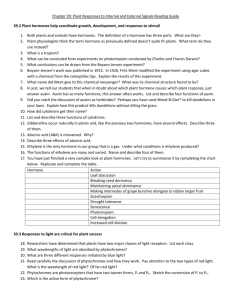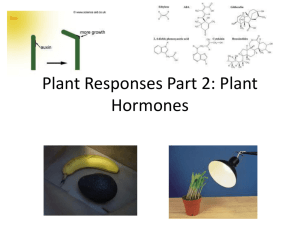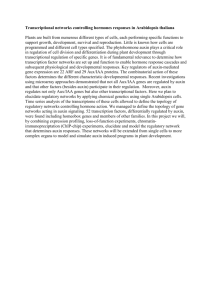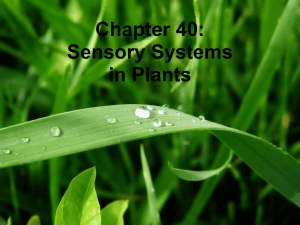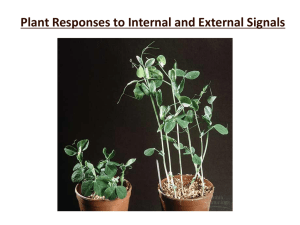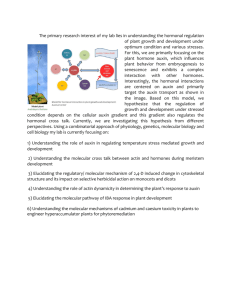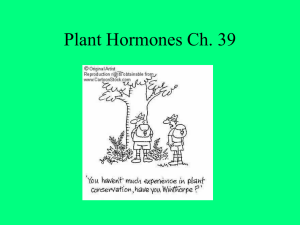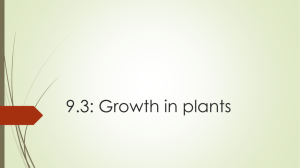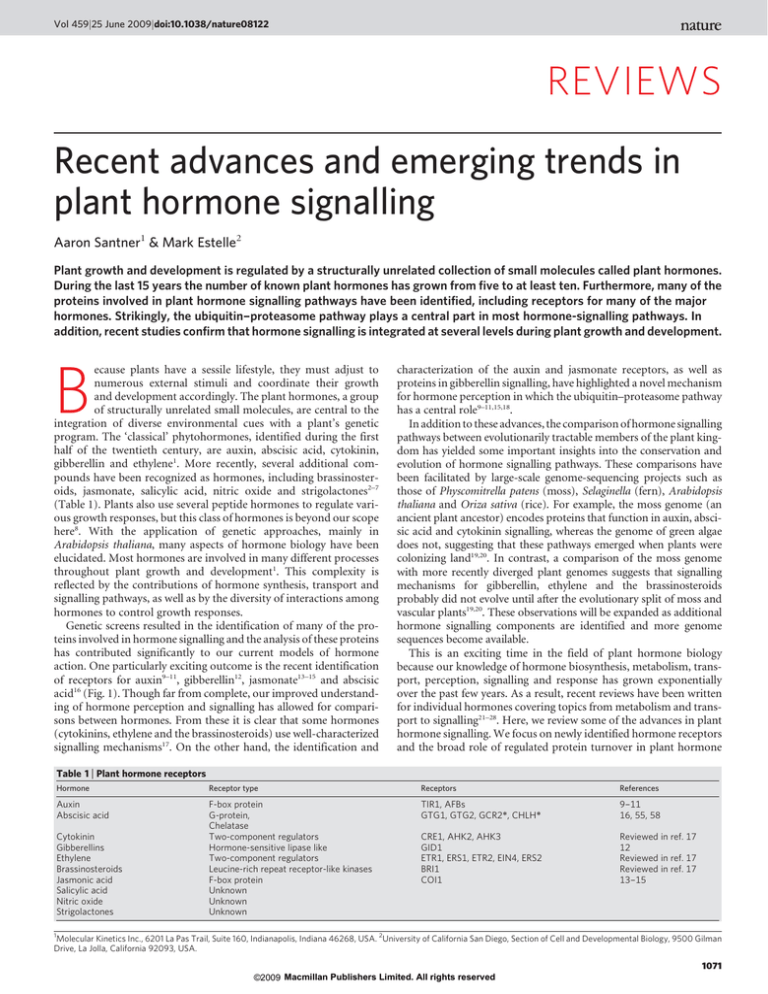
Vol 459j25 June 2009jdoi:10.1038/nature08122
REVIEWS
Recent advances and emerging trends in
plant hormone signalling
Aaron Santner1 & Mark Estelle2
Plant growth and development is regulated by a structurally unrelated collection of small molecules called plant hormones.
During the last 15 years the number of known plant hormones has grown from five to at least ten. Furthermore, many of the
proteins involved in plant hormone signalling pathways have been identified, including receptors for many of the major
hormones. Strikingly, the ubiquitin–proteasome pathway plays a central part in most hormone-signalling pathways. In
addition, recent studies confirm that hormone signalling is integrated at several levels during plant growth and development.
ecause plants have a sessile lifestyle, they must adjust to
numerous external stimuli and coordinate their growth
and development accordingly. The plant hormones, a group
of structurally unrelated small molecules, are central to the
integration of diverse environmental cues with a plant’s genetic
program. The ‘classical’ phytohormones, identified during the first
half of the twentieth century, are auxin, abscisic acid, cytokinin,
gibberellin and ethylene1. More recently, several additional compounds have been recognized as hormones, including brassinosteroids, jasmonate, salicylic acid, nitric oxide and strigolactones2–7
(Table 1). Plants also use several peptide hormones to regulate various growth responses, but this class of hormones is beyond our scope
here8. With the application of genetic approaches, mainly in
Arabidopsis thaliana, many aspects of hormone biology have been
elucidated. Most hormones are involved in many different processes
throughout plant growth and development1. This complexity is
reflected by the contributions of hormone synthesis, transport and
signalling pathways, as well as by the diversity of interactions among
hormones to control growth responses.
Genetic screens resulted in the identification of many of the proteins involved in hormone signalling and the analysis of these proteins
has contributed significantly to our current models of hormone
action. One particularly exciting outcome is the recent identification
of receptors for auxin9–11, gibberellin12, jasmonate13–15 and abscisic
acid16 (Fig. 1). Though far from complete, our improved understanding of hormone perception and signalling has allowed for comparisons between hormones. From these it is clear that some hormones
(cytokinins, ethylene and the brassinosteroids) use well-characterized
signalling mechanisms17. On the other hand, the identification and
B
characterization of the auxin and jasmonate receptors, as well as
proteins in gibberellin signalling, have highlighted a novel mechanism
for hormone perception in which the ubiquitin–proteasome pathway
has a central role9–11,15,18.
In addition to these advances, the comparison of hormone signalling
pathways between evolutionarily tractable members of the plant kingdom has yielded some important insights into the conservation and
evolution of hormone signalling pathways. These comparisons have
been facilitated by large-scale genome-sequencing projects such as
those of Physcomitrella patens (moss), Selaginella (fern), Arabidopsis
thaliana and Oriza sativa (rice). For example, the moss genome (an
ancient plant ancestor) encodes proteins that function in auxin, abscisic acid and cytokinin signalling, whereas the genome of green algae
does not, suggesting that these pathways emerged when plants were
colonizing land19,20. In contrast, a comparison of the moss genome
with more recently diverged plant genomes suggests that signalling
mechanisms for gibberellin, ethylene and the brassinosteroids
probably did not evolve until after the evolutionary split of moss and
vascular plants19,20. These observations will be expanded as additional
hormone signalling components are identified and more genome
sequences become available.
This is an exciting time in the field of plant hormone biology
because our knowledge of hormone biosynthesis, metabolism, transport, perception, signalling and response has grown exponentially
over the past few years. As a result, recent reviews have been written
for individual hormones covering topics from metabolism and transport to signalling21–28. Here, we review some of the advances in plant
hormone signalling. We focus on newly identified hormone receptors
and the broad role of regulated protein turnover in plant hormone
Table 1 | Plant hormone receptors
Hormone
Receptor type
Receptors
References
Auxin
Abscisic acid
F-box protein
G-protein,
Chelatase
Two-component regulators
Hormone-sensitive lipase like
Two-component regulators
Leucine-rich repeat receptor-like kinases
F-box protein
Unknown
Unknown
Unknown
TIR1, AFBs
GTG1, GTG2, GCR2*, CHLH*
9–11
16, 55, 58
CRE1, AHK2, AHK3
GID1
ETR1, ERS1, ETR2, EIN4, ERS2
BRI1
COI1
Reviewed in ref. 17
12
Reviewed in ref. 17
Reviewed in ref. 17
13–15
Cytokinin
Gibberellins
Ethylene
Brassinosteroids
Jasmonic acid
Salicylic acid
Nitric oxide
Strigolactones
1
Molecular Kinetics Inc., 6201 La Pas Trail, Suite 160, Indianapolis, Indiana 46268, USA. 2University of California San Diego, Section of Cell and Developmental Biology, 9500 Gilman
Drive, La Jolla, California 92093, USA.
1071
©2009 Macmillan Publishers Limited. All rights reserved
REVIEWS
NATUREjVol 459j25 June 2009
Brassinosteroids
Abscisic acid
Cytokinin
GTG1/2
CRE1
AHK2
AHK3
BRI1
Abscisic acid
PYR1/RCAR1
Endosome
Ethylene
CH2=CH2
IAA
ETR1
ETR2
EIN4
Jasmonate
ERS1
ERS2
TIR1
COI1
Nucleus
GID1
Endoplasmic
reticulum
Gibberellin
Figure 1 | Sites of plant hormone perception. BRI1 is a membraneassociated receptor that cycles between the plasma membrane and
endosomal compartments. The extracellular leucine-rich repeat domain
binds brassinosteroids and transduces the signal through an intracellular
kinase domain. GTG1 and GTG2 are GPCR-type G proteins that bind
abscisic acid. They have inherent GTPase activity but also interact with the
only canonical Ga subunit in Arabidopsis. PYR1/RCAR1 is a soluble ABA
receptor that represses PP2C phosphatases in the presence of ABA. The
cytokinin receptors CRE1, AHK2 and AHK3 are plasma-membraneassociated and perceive cytokinin through their extracellular domains.
Cytokinin binding triggers a phosphorylation cascade that is ultimately
transmitted to response regulators in the nucleus. Like the cytokinin
receptors, the known ethylene receptors are two-component regulators. All
five receptors are active in the endoplasmic reticulum and transmit their
signal through a common downstream component called CTR1. TIR1 and
COI1 are F-box proteins that are integral components of SCF-type E3 ligases
and recognize the plant hormones auxin and jasmonic acid respectively.
GID1 is a nuclear-localized receptor for gibberellins. Gibberellin binding to
GID1 results in the enhanced degradation of DELLA proteins.
signalling pathways. We also discuss some of the ways that hormone
pathways are integrated during plant growth and development.
Auxin perception by a new class of receptor
Auxin is crucial in regulating plant growth and development from
embryogenesis through maturity. As were most hormone signalling
proteins identified in plants, the auxin receptors were first found
through mutant screens. In this case the screen was for Arabidopsis
seedlings with an altered response to auxin or auxin-transport inhibitors. Many of the auxin-resistant mutants identified in this way are
disrupted in components of the Skp1/Cullin/F-box (SCF) ubiquitin
ligases (E3) or in proteins that regulate SCF activity29.
The E3 ligases are the last enzymes in the ubiquitin–proteinconjugation pathway and confer specificity to the pathway. In the
case of SCF-type E3 ligases, the F-box protein interacts directly
with the substrate and thus determines the substrate specificity of
the complex30. SCFs were first implicated in auxin signalling with the
identification of an F-box protein called TIR1. Recessive mutations in
TIR1 confer auxin resistance, implying that the protein is required for
degradation of negative regulators of auxin response31. A key event in
the characterization of the auxin-signalling pathway was the discovery
that SCFTIR1 is directly linked to auxin-regulated transcription32.
The auxin transcriptional response is controlled by two large families
of transcription factors; the auxin/indole-3-acetic acid (Aux/IAA)
proteins and the auxin response factors (ARFs) (of which Arabidopsis
has 29 and 23 members respectively). ARFs bind the promoters of
auxin-responsive genes and either activate or inhibit transcription
depending on the type of ARF33. The Aux/IAA proteins bind to the
ARFs through shared domains in both proteins called domains III and
IV and repress auxin-regulated transcription34. Importantly, the Aux/
IAA proteins are short-lived; their degradation is promoted by auxin
and dependent upon TIR1. Many gain-of-function mutations in Aux/
IAA genes have been isolated and in every case the mutations affect
residues within a highly conserved region called domain II34.
Biochemical studies demonstrated that domain II binds TIR1 and that
this binding is enhanced by auxin32,35,36.
Although these results suggested a mechanism for auxin-dependent
de-repression of transcription, how auxin promotes the SCFTIR1–
Aux/IAA interaction remained unclear. Ultimately, TIR1 itself was
shown to bind biologically active auxins directly and specifically9,11.
Auxin binding to TIR1 increases the stability of the TIR1–Aux/IAA
complex. Structural studies of TIR1 in the presence of auxin and a
peptide encompassing domain II revealed how auxin promotes Aux/
IAA degradation37. A single hydrophobic pocket on the surface of the
leucine-rich repeat domain of TIR1 binds both auxin and the domain
II peptide37. Auxin binds to residues at the base of this pocket and
contributes to binding of the Aux/IAA protein37. Domain II of the
canonical Aux/IAAs interacts with TIR1 residues directly above auxin,
filling the remainder of the pocket37. One important implication of the
structure is that both TIR1 and the Aux/IAAs appear to contribute to
high-affinity binding of auxin. In this sense, it may be more appropriate to call TIR1 and the Aux/IAA protein co-receptors. If true, this
also implies that different combinations of F-box protein and substrate may have unique auxin-binding characteristics.
Auxin research has a long history and the discovery that TIR1
functions as an auxin receptor was groundbreaking in several
respects. The work indicates that F-box proteins, and perhaps other
E3 ligases, can function as receptors for small molecules. Indeed,
studies have demonstrated that this is probably true (see jasmonate
signalling below). Further, the discovery that a small molecule can
significantly enhance the interaction between an E3 and its substrate
presents a new strategy for the development of drugs that target the
ubiquitin–proteasome pathway38. Finally, detailed knowledge of
auxin receptor function may stimulate the development of new plant
growth regulators39.
Recent results have also shed new light on the mechanism of Aux/
IAA repression. Earlier studies showed that conserved domain I in the
Aux/IAA proteins is required for transcriptional repression but the
mechanism of repression was unclear40. Domain I of most Aux/IAAs
contains an ethylene-response-factor-associated amphiphilic repression motif40. In 2008, a protein called TOPLESS (TPL) was shown to
associate with domain I of the Aux/IAA protein IAA12 and to function
as a transcriptional co-repressor41. These findings support an updated
model in which the Aux/IAA proteins act as repressors of ARFmediated transcription by recruiting TPL or related transcriptional
co-repressors to the multi-protein complex41. Auxin de-represses transcription by promoting ubiquitination and subsequent degradation of
Aux/IAA proteins through the action of SCFTIR1. Without the Aux/
IAA proteins, TPL is no longer associated with promoters of auxinregulated genes (Fig. 2). Important questions about this model still
remain. For example it is not known whether SCFTIR1 interacts with the
Aux/IAA while in a complex with TPL and an ARF, with an ARF alone,
or perhaps by itself. In addition, each of the relevant proteins is part of a
large family (6 TIR1/AFBs, 29 Aux/IAAs, 23 ARFs, 5 TPL/TOPLESS
1072
©2009 Macmillan Publishers Limited. All rights reserved
REVIEWS
NATUREjVol 459j25 June 2009
a
b
c
Low intracellular jasmonate
Low intracellular IAA
TIR1/AFB
E2
ASK1
RBX
CUL1
Low intracellular gibberellin
SLY1/GID2
COI1
E2
ASK1
RBX
CUL1
E2
RBX
CUL1
ASK1
GID1
TPL
DELLA
AuxIAA
JAZ
Auxin
response
ARF
High intracellular IAA
PIF3/4
MYC2
High intracellular gibberellin
High intracellular jasmonate
26S
proteasome
Gibberellin
response
Jasmonate
response
26S
proteasome
26S
proteasome
JAR1
TPL
AuxIAA
JAZ
TIR1/AFB
E2
ASK1
RBX
CUL1
ARF
Auxin
response
GID1
Ile
COI1
E2
ASK1
RBX
CUL1
MYC2
Jasmonate
response
DELLA
SLY1/GID2
E2
ASK1
RBX
CUL1
PIF3/4
Gibberellin
response
Figure 2 | SCFs are required for auxin, jasmonate and gibberellin
signalling. a, The TIR1/AFB family of F-box proteins are auxin receptors.
TIR1 is a component of the SCF complex that also consists of ASK, CUL and
RBX. Auxin binding stabilizes the TIR1-AUX/IAA complex, resulting in
degradation of the AUX/IAAs, which in turn releases TPL and permits ARFdependent transcription. b, Binding of JA-Ile to COI1 promotes JAZ binding
and ubiquitination. This results in de-repression of MYC2-dependent
transcription of jasmonate-responsive genes. c, Gibberellin binding to the
GID1 receptor promotes GID1–DELLA complex formation. GID1–DELLA
binding promotes the interaction between the C terminus of the DELLA
protein and SCFSLY1/GID2. Degradation of the DELLAs promotes the release
of PIFs, thus permitting DNA-binding gibberellin responses. In each panel,
the hormone receptor is coloured red, the substrate protein is light blue,
symbols representing hormones are yellow and components of the
ubiquiting proteasome pathway are in grey. Black circles represent
ubiquitin.
RELATEDs) and the potential specificity of interactions between different family members is just beginning to be explored.
proteasome-dependent manner following jasmonate treatment, but
were stabilized in the coi1-1 background, implicating SCFCOI1 in the
JAZ degradation pathway. Furthermore, members of the JAZ family
were shown to interact with COI1 both in vitro and in a yeast twohybrid test13,14. Indeed, subsequent biochemical analyses showed that
radiolabelled coronatine binds to COI1-JAZ complexes with high affinity15,45. Interestingly, these studies also showed that jasmonate conjugated to isoleucine (JA-Ile) is the active molecule45. Taken together, the
data suggest that SCFCOI1 serves as a receptor for JA-Ile in order to
stabilize the interaction between the F-box protein and its substrate.
The similarity between auxin signalling and jasmonate signalling
does not end there. JAZ proteins do not have an obvious DNAbinding domain, suggesting that their effects on transcription could
be indirect. Pull-down and yeast-two-hybrid assays indicate that the
carboxy-terminal domain of JAZ3 (also known as JAI) interacts with
sequences at the amino terminus of MYC2, a well-characterized
transcription factor that modulates jasmonate-mediated transcription13. This raises the possibility that JAZ3/JAI directly blocks MYC2
function. JAZ3/JAI degradation via SCFCOI1 in response to jasmonate
would permit MYC2 to activate or repress downstream target genes
in jasmonate signalling cascades. Several of the JAZ genes are themselves upregulated in response to jasmonate13, indicating that a negative feedback mechanism may limit the response after jasmonate
perception, again much like the auxin signalling pathway (Fig. 2).
Jasmonate perception is similar to that of auxin
It is now clear that TIR1 and its closest relatives the auxin-signalling
F-box proteins (AFBs) serve as receptors for auxin10. There are
roughly 700 F-box proteins encoded by the Arabidopsis genome.
This raises the question: do any other F-box proteins function as
receptors for plant hormones? Recent findings on jasmonate perception and signalling strongly suggest that jasmonate and auxin share a
conserved mechanism of hormone sensing and response.
The oxylipin jasmonic acid and its metabolites, collectively known
as jasmonates, are important plant signalling molecules that mediate
biotic and abiotic stress responses as well as aspects of growth and
development23. One of the mutants that helped define the role of
jasmonate in plant growth is the Arabidopsis coronatine-insensitive1
(coi1) mutant42. Coronatine is a phytotoxin that is structurally and
biologically related to jasmonate. The coi1 mutant is resistant to both
coronatine and methyl jasmonate, and also confers male sterility42.
Subsequent studies demonstrated that coi1 mutants are perturbed in
every aspect of jasmonate response, indicating that COI1 has an
essential role in jasmonate signal transduction. COI1 encodes an
F-box protein that is closely related to TIR143. These results suggested
that jasmonate response requires SCFCOI1-dependent degradation of
repressors in much the same way as SCFTIR1 targets the Aux/IAAs.
However, until 2007 the SCFCOI1substrates were unknown.
This changed when a novel family of transcriptional regulators called
JAZ proteins (jasmonate ZIM-domain) was identified13,14,44. These
groups showed that several full-length JAZ proteins are degraded in a
Ubiquitination is a recurring theme
The newly identified receptors for auxin and jasmonic acid dramatically illustrate the importance of the ubiquitin–proteasome pathways in hormone signalling. However, it is also clear that targeted
1073
©2009 Macmillan Publishers Limited. All rights reserved
REVIEWS
NATUREjVol 459j25 June 2009
protein turnover is an integral component in several other hormone
signalling pathways.
Gibberellin signalling. Like auxin, gibberellins play a major role in
diverse growth processes, including seed development, organ elongation and the control of flowering time24. Physiological data demonstrate that gibberellin responses are negatively regulated by DELLA
proteins. (The DELLA proteins get their name from the conserved
N-terminal DELLA domain18.) Recent work exploring the integration of light and gibberellin signals during cell elongation has elucidated a model for DELLA-mediated growth regulation. DELLA
proteins were shown to interact directly with the DNA-binding
domain of two basic helix–loop–helix transcription factors (PIF3
and PIF4), sequestering them in inactive complexes46,47. Gibberellin
accumulation destabilizes DELLAs, freeing PIF3 and PIF4 to activate
the transcription of their target genes46,47. It is likely that DELLAs
regulate the activity of several other transcription factors by this
mechanism, as PIF3 and PIF4 are members of a larger subfamily of
basic helix–loop–helix proteins that have similar DNA-binding
domains.
Mutations within the DELLA domain of DELLA proteins result in
a dominant gain-of-function gibberellin-insensitive phenotype18.
Further, the DELLAs were found to accumulate in Arabidopsis and
rice mutants defective in the F-box protein genes sleepy1 (sly1) and
gibberellin-insensitive dwarf2 (gid2), respectively48,49. Thus, as
observed in auxin and jasmonate signalling, gibberellin appears to
regulate the abundance of a transcriptional repressor family by promoting ubiquitination through the activity of SCF-type ligases.
The gibberellin receptor was first identified in a genetic screen for
signalling mutants in rice12. The gibberellin-insensitive dwarf 1 (gid1)
mutant is completely insensitive to gibberellin-treatment, suggesting a
prominent role for the protein in gibberellin signalling12. The GID1
protein is nuclear-localized and binds biologically active gibberellins12.
Three orthologous genes—GID1a, GID1b and GID1c—were identified
in Arabidopsis and mutations in each gene were obtained and combined to study their contributions to the gibberellin response50,51. The
gid1a–c triple mutant is gibberellin-insensitive, suggesting that all gibberellin responses require functional GID1 proteins in both rice and
Arabidopsis51.
The GID1 proteins interact with DELLA proteins in a gibberellindependent manner12,51,52. Furthermore, co-expression of the GID1
receptor enhances the interaction between DELLA proteins and the
F-box proteins SLY1/GID251. These data suggest that DELLAs are
better able to interact with SCFGID2/SLY while in a complex with
gibberellin-bound GID1. This interaction ultimately leads to ubiquitination and degradation of the DELLA repressor, thus promoting
gibberellin-mediated transcription (Fig. 2).
The structures of rice GID1 and Arabidopsis GID1a have recently
been reported and support this model53,54. GID1 has sequence and
structural similarities to members of the hormone-sensitive lipase
family. Like hormone-sensitive lipases, the GID1 primary structure
forms a deep binding pocket whose access is controlled by an
N-terminal flexible lid53,54. Gibberellin binding to GID1 probably
induces the protein to adopt a compact form, with the N-terminal
lid folding back over the gibberellin-binding pocket53,54. DELLA–
GID1 interaction is achieved through three conserved motifs in the
DELLA domain (DELLA, VHYNP and LExLE) that directly contact
the N-terminal lid of GID153. It is not yet clear how complex formation enhances the DELLA-SCFSLY/GID2 interaction, but it may involve
a conformational change in the C-terminal GRAS domain of the
DELLA proteins53.
Abscisic-acid signalling. Much recent work has elucidated putative
mechanisms of abscisic-acid perception. A number of potential
abscisic-acid receptors have recently been described but some of
these studies have been controversial. One candidate, magnesium
protoporphyrin-IX chelatase H subunit (CHLH), also known as
GUN5 in Arabidopsis, was reported to have specific abscisic-acidbinding activity55. This group also presented data indicating that
Arabidopsis plants with decreased CHLH levels have abscisic-acidinsensitive germination and stomatal aperture phenotypes, while
plants overexpressing CHLH are hypersensitive to abscisic acid in
these assays. However, GUN5 is an unconventional site of abscisicacid perception because it is localized to chloroplasts55,56. Further, a
recent study reported that barley CHLH did not bind abscisic acid
and that mutants with reduced CHLH levels did not display an
abscisic-acid phenotype, casting doubt on the idea that this protein
is an abscisic-acid receptor57.
The second candidate abscisic-acid receptor is a G-proteincoupled receptor called GCR258. This suggestion is also controversial
because the presence of a proposed transmembrane domain in GCR2
has been disputed59. Furthermore, genetic analysis of gcr2 mutants
failed to detect an abscisic-acid-related phenotype and some biochemical studies indicate that GCR2 does not bind abscisic acid after
all60–62. At this point, it seems unlikely that GCR2 functions as an
abscisic-acid receptor.
Three very recent papers show more promise. In a study from the
Assman laboratory, another pair of G-protein-coupled receptors
have been implicated in abscisic-acid response, GTG1 and GTG216.
Genetic evidence indicates that GTG1 and GTG2 act redundantly to
mediate abscisic-acid responses during germination, flowering, root
elongation and stomatal closure16. Perhaps more importantly, GTG1
and GTG2 were demonstrated to bind biologically active abscisic acid
specifically in in vitro binding assays. Furthermore, the abscisic-acid
binding dissociation constants of ,35 nM for GTG1 and ,41 nM for
GTG2 fall within a physiologically relevant range.
Finally, two other papers present compelling evidence that a family
of START proteins function as abscisic-acid receptors63,64. One of
these studies began with the discovery of a selective abscisic-acid
agonist called pyrabactin63. A genetic screen for pyrabactin targets
led to the identification of the PYRABACTIN RESISTANCE 1 (PYR1)
gene, encoding a cyclase subfamily member in the START domain
superfamily. Mutants deficient in PYR1 and at least two additional
members of the PYR1-LIKE (PYL) family are strongly abscisic-acidresistant63. To learn more about the function of these proteins, the
Cutler group63 performed a yeast-2-hybrid screen using PYR1 as bait.
They recovered HAB1, a member of a family of PP2C protein phosphatases known to regulate abscisic-acid signalling. The best characterized of these is ABI1. Strikingly, the interaction between PYR1
and the PP2C proteins depends on abscisic acid. Further, the PYR1
binding inhibits the phosphatase activity. At the same time, the Grill
group were screening for ABI1 interacting proteins in yeast64. They
identified a protein called RCAR1, which turned out to be identical to
PYL9. Like PYR1, RCAR1 interacts with ABI1 in an abscisic-aciddependent manner and inhibits its activity. Together, these studies
suggest a fascinating model in which abscisic-acid signalling requires
repression of PP2Cs through the action of PYR1/RCAR1 and related
proteins63,64. At this point the relationship between the GTGs and
PYR1/RCAR1 is unknown. However, abscisic-acid responses are
diverse and it is possible that this diversity requires multiple sites
of perception65.
The intermediate signalling steps between abscisic-acid perception
and response are unclear but the ubiquitin–proteasome pathway is
known to be important (Fig. 3). Two RING E3 ligases, ABI3Interacting Protein (AIP2) and Keep on Going (KEG), promote normal abscisic-acid signalling by regulating the abundance of abscisicacid-responsive transcription factors, namely ABA-Insensitive 3
(ABI3) and ABA-Insensitive 5 (ABI5)66,67. ABI3 levels are reduced
as abscisic-acid levels increase in cells. The detailed mechanism is
unknown but there is evidence suggesting that abscisic acid increases
AIP2 transcript and protein levels66. Increasing AIP2 levels then promotes the ubiquitination and degradation of ABI3, contributing to
its accelerated degradation. Conversely, abscisic acid protects ABI5
from ubiquitin-mediated degradation, causing ABI5 levels to
increase in response to the hormone. KEG has been implicated in
the regulation of ABI5 and abscisic-acid signalling may prevent either
1074
©2009 Macmillan Publishers Limited. All rights reserved
REVIEWS
NATUREjVol 459j25 June 2009
a
Low ethylene
EIN2
ETP1/2
E2
ASK1
Increased
ethylene
RBX
CUL1
EIN3
EBF1/2
E2
ASK1
RBX
CUL1
Ethylene
response
studies of series of mutants including ramosus (rms) of pea, dwarf
(d) of rice, more axillary growth (max) of Arabidopsis, and decreased
apical dominance (dad) of petunia indicated that axillary bud outgrowth is also inhibited by an unidentified hormone73. Several
affected genes were identified and found to encode CAROTENOID
CLEAVAGE DIOXYGENASE 7 (max3, rms5, d17) or CCD8 (max4,
rms1, d10, and dad1), suggesting that the hormone was related to
carotenoids73. Very recently, two independent groups showed that
levels of strigolactone, a carotenoid derivative, were reduced in rice d
mutants and the pea rms1 mutant6,7. Treating the respective rice and
pea mutants with the synthetic strigolactone GR24 restored axillary
bud outgrowth inhibition, suggesting that strigolactones are branching hormones6,7. In the context of shoot branching, it is interesting to
note that an F-box protein called MAX2/RMS4 is required for response to strigolactone74,75. We expect to learn soon whether MAX2/
RMS4 is the strigolactone receptor.
Integration of hormone signalling
b
E2
ABI3
AIP2
Abscisic acid
E2
ABI5
KEG
Abscisic acid
response
Figure 3 | E3 ligases in ethylene and abscisic-acid signalling. a, Two key
proteins in the ethylene signalling pathway are regulated by SCF-type E3
ligases. In the absence of ethylene, EIN2 levels are kept low by SCFETP1 and
SCFETP2. As ethylene levels increase, ETP1/2 expression is reduced and EIN2
levels increase. Concomitantly, EIN3 levels also increase, in part due to the
effects of EIN2 on SCFEBF1/2-mediated degradation of EIN3. b, ABI3 and
ABI5 levels are controlled by the RING E3 ligases AIP2 and KEG,
respectively. Abscisic acid promotes the ubiquitination of ABI3 and inhibits
the ubiquitination of ABI5 to promote abscisic-acid responses. Black circles
denote ubiquitin.
the recognition or the ubiquitination of ABI5 by KEG67. keg seedlings
have a severe phenotype that includes growth arrest immediately
following germination. Reducing ABI5 levels in keg mutants rescues
some but not all aspects of the phenotype, suggesting a broader role
for KEG in abscisic-acid signalling that may also extend to other
abscisic-acid-responsive transcription factors67.
Ethylene signalling. Ethylene signalling is also dependent on regulated protein turnover. ETHYLENE INSENSITIVE 3 (EIN3) is a
positive transcriptional regulator required for transcription of
ETHYLENE RESPONSE FACTOR genes68. EIN3 levels are regulated
through the action of at least two related F-box proteins, EIN3Binding F-box 1 (EBF1) and EBF269,70. SCFEBF1 is thought to repress
EIN3 levels when ethylene is low71. Two putative functions have been
suggested for SCFEBF2. SCFEBF2 may prevent excessive accumulation
of EIN3 or perhaps remove it when ethylene levels decrease (Fig. 3).
Normal ethylene responses are thought to decrease the degradation
of EIN3 by SCFEBF1 and SCFEBF2, thereby increasing EIN3 levels
within responding cells71.
More recently, another pair of F-box proteins—ETP1 and ETP2—
have been shown to promote degradation of the ethylene signalling
protein EIN2 in the absence of ethylene72. When ethylene is present,
expression of ETP1 and ETP2 is reduced, allowing accumulation of
EIN2. Thus the ubiquitin pathway is involved in ethylene signalling at
multiple points in the pathway.
Strigolactone signalling. For many years auxin and cytokinin were
thought to be the major mediators of shoot branching. However,
Crosstalk between hormones is a very active area of research that has
benefited from the recent elucidation of hormone signalling pathways. Although our knowledge of the molecular components and
pathways that mediate hormone responses has improved enormously in recent years, the molecular mechanisms of hormone interaction remain poorly understood. The coming years should see a
greater focus on the function of each hormone pathway in the context
of larger regulatory networks.
Evidence for hormone crosstalk comes largely from the analysis of
mutant phenotypes. Frequently mutants that are affected in one
hormone pathway also display changes in other hormone responses.
For example, auxin-related mutants such as tir1, aux1 and pin2
exhibit altered response to other hormones, including ethylene and
abscisic acid76,77. From these studies and many others it is clear that
hormone crosstalk is as complex as it is important. Almost certainly,
all plant hormones interact with one or more additional hormones by
affecting synthesis, transport or response. The type of interaction
often depends on the tissue, developmental stage and environmental
conditions. This presents a nearly endless number of possible opportunities for regulation. Even though the documented instances of
crosstalk are numerous, our current knowledge of hormone interaction is quite sketchy. Here we will discuss some of the broad strategies for integrating hormone responses through examples from the
recent literature.
It has become clear that diverse mechanisms have evolved to
coordinate activity of hormonal pathways during development
(Fig. 4). A prominent example is the regulation of hormone metabolism by an interacting hormone. This mechanism is exemplified by
ethylene and auxin. Measurement of the rate of auxin biosynthesis
after ethylene treatment revealed that ethylene stimulates the auxin
biosynthetic pathway. Indeed, several genes required for auxin biosynthesis are under the transcriptional control of ethylene. These
genes encode both the alpha and beta subunits of anthranilate
synthase (ASA1 and ASB1) and a newly identified family of tryptophan aminotransferases (TAA1)78–80. These enzymes function in
tryptophan synthesis and the indole-3-pyruvic auxin biosynthetic
pathway, respectively.
Auxin can influence ethylene biosynthesis as well. One of the
rate-limiting enzymes in the ethylene biosynthesis pathway is 1aminocyclopropane-1-carboxylate synthase (ACS)81. In Arabidopsis, there are nine ACS genes that can homodimerize or heterodimerize to form active enzymes82. Several of the ACS genes have been
found to be regulated by auxin treatment at the transcriptional
level81. Auxin has also been implicated in the production of jasmonic
acid in flowers. Mutant analysis of arf6 arf8 double mutant plants
demonstrated a role in the coordination transition from immature to
mature flowers83. During floral development, jasmonate levels peak
just before anther dehiscence and then decrease83. Direct measurements showed that jasmonate production was reduced in arf6 arf8
1075
©2009 Macmillan Publishers Limited. All rights reserved
REVIEWS
NATUREjVol 459j25 June 2009
(ASA1, ASB1,
TAA1)
Auxin biosynthesis
Ethylene
Gibberellin
Auxin
DELLA
degradation
Cytokinin
Brassinosteroids
(PIN genes)
(BIN2)
(ACS genes)
Auxin transport
Auxin signalling
Ethylene
biosynthesis
Abscisic
acid
Figure 4 | Hormone integration. Auxin and ethylene maintain an important
balance in cells, in part by regulating synthesis. Both hormones exert
transcriptional control over critical genes in biosynthesis. A second
mechanism of crosstalk is through the control of hormone transport.
Cytokinin and auxin are antagonistic during lateral root initiation. To
inhibit lateral root formation, cytokinin represses PIN expression, thereby
inhibiting formation of an auxin gradient required for lateral root initiation.
Brassinosteroids and auxin coordinate growth, in part by regulating an
overlapping set of genes. In addition, phosphorylation of ARF2 by a
brassinosteroid-regulated kinase modulates the activity of ARF2. Finally,
auxin, ethylene and abscisic acid all converge on the DELLA proteins.
mutants at every stage of floral development83. Furthermore, gene
expression studies revealed that several known jasmonate biosynthetic genes were underexpressed in arf6 arf8 mutants, revealing a
regulatory role for auxin in jasmonate production83.
Hormone interactions also occur at the level of hormone distribution. An illustrative example of this type of crosstalk is the opposing action of auxin and cytokinin during lateral root initiation. It is
widely known that polar auxin transport and the establishment of an
auxin gradient is a very important determinant of plant growth and
morphological patterning84. During root development, auxin promotes lateral root initiation while cytokinin opposes this response.
One way that cytokinin exerts this effect is to influence the expression
of the PIN auxin-efflux carrier genes85. At least five PIN genes work
collectively to establish auxin gradients in roots by controlling the
direction of polar-auxin transport86. By reducing PIN expression,
cytokinin disrupts the local auxin gradient formation in lateral root
founder cells, thereby inhibiting lateral root initiation85.
Hormonal signalling pathways are also known to interact at the
level of gene expression. For example, studies show that there is
significant overlap between auxin- and brassinosteroid-responsive
gene sets87,88. Generally, common target genes repressed by auxin
are also repressed by brassinosteroids, and genes induced by auxin
are induced by brassinosteroids, suggesting coordination between
the signalling pathways. Furthermore, transcriptional profiling in
the brassinosteroid-deficient mutant brx showed that very few auxin
response genes responded normally to auxin89. Conversely, many
brassinosteroid-responsive genes are mis-regulated in the yucca
mutant that overproduces auxin87. Taken together, the data suggest
that auxin and brassinosteroid signalling pathways often converge on
a set of common target genes. A molecular mechanism for this convergence was recently elucidated in which the brassinosteroidregulated BIN2 kinase directly regulates ARF2 activity90. ARF2 is an
auxin-response factor that inhibits the transcription of auxinresponsive genes. The phosphorylation of ARF2 by BIN2 disrupts
DNA binding, leading to inactivation of ARF2 and a subsequent
increase in transcription of auxin-responsive genes90.
Control over key components of signalling pathways by other
hormone signals is another common example of cross-talk strategy.
As described above, DELLA proteins are central regulators of the
gibberellin-mediated signalling pathway and appear to be a common
crosstalk node for several interacting hormones, including auxin,
ethylene and abscisic acid91. Gibberellin signalling during root elongation is known to require auxin because disruption of polar auxin
transport or signalling diminished the effects of gibberellin on root
elongation92. The attenuated growth response corresponded with
reduced RGA (a specific DELLA protein) degradation in root cells.
These observations indicate that auxin promotes the gibberellininduced destabilization of some of the DELLA proteins to affect gibberellin responses92.
Similarly, ethylene may also target DELLA proteins to exert
antagonistic actions with gibberellin during root growth93. The
gibberellin-insensitive gai/rga mutant exhibits ethylene-insensitive
root growth, indicating that ethylene regulates root growth in a
DELLA-dependent manner93. In Arabidopsis roots, abscisic acid
and gibberellin act antagonistically during root growth. Application of abscisic acid was demonstrated to stabilize the DELLA protein
RGA and inhibit its gibberellin-induced degradation94. Furthermore,
higher-order DELLA mutants are resistant to the effects of abscisic
acid on growth inhibition94. DELLA proteins are not only a node for
various hormone signal inputs but also mediate hormone signalling
pathways in addition to gibberellin response. DELLA proteins were
recently implicated as modulators of plant immune responses95.
Genetic studies showed that DELLA proteins promote susceptibility
to virulent biotrophs and resistance to necrotrophs. These observations were attributed, at least partially, to an alteration of the balance
between salicylic acid and jasmonate signalling95.
These are but a few of the common strategies used to coordinate
hormone signals. The regulatory network connecting individual
pathways is far more complex in that hormone interactions can result
in different outcomes depending on the organ, developmental stage
and environmental conditions. Continued efforts to describe the
plant hormone regulatory network will be essential to understand
and predict plant growth and development.
Concluding remarks
This is a very exciting time for plant hormone biologists as the rate of
discovery has expanded exponentially in recent years. The number of
recognized small-molecule hormones has doubled in the past 15
years. Candidate receptors for all of the ‘classical’ hormones and a
few of the newer hormones have been identified. We now know the
structure of several receptors, leading to exciting new models of
hormone perception and new opportunities to synthesize novel
growth regulators. Likewise, major advances have been achieved in
our knowledge of downstream signalling components and some of
their interactions. As we move forward, a major challenge will be to
understand how hormone-signalling pathways are integrated during
environmental control of plant growth. To take one example, auxin,
gibberellin and the brassinosteroids are all known to promote elongation of the Arabidopsis hypocotyl. However, the relative contribution
of each signalling pathway to growth regulation by light, temperature
or the circadian clock is uncertain. Similarly, it is not known whether
cell elongation in the hypocotyl requires the same set of genes,
regardless of the growth signal. The answers to these and other questions will require a detailed characterization of growth responses,
together with information on corresponding changes in the transcriptome and proteome, ideally at cellular resolution. Computational tools can be used to identify the gene modules associated with
diverse growth responses. Ultimately, this information can be used to
develop predictive models of plant growth and development that will
be invaluable tools for modern agriculture.
1.
2.
3.
4.
5.
Davies, P. J. in Plant Hormones: Physiology, Biochemistry and Molecular Biology (ed.
Davies, P. J.) 1–12 (Kluwer Academic, 1995).
Grun, S., Lindermayr, C., Sell, S. & Durner, J. Nitric oxide and gene regulation in
plants. J. Exp. Bot. 57, 507–516 (2006).
Vert, G., Nemhauser, J. L., Geldner, N., Hong, F. & Chory, J. Molecular mechanisms
of steroid hormone signaling in plants. Annu. Rev. Cell Dev. Biol. 21, 177–201
(2005).
Browse, J. Jasmonate: an oxylipin signal with many roles in plants. Vitam. Horm.
72, 431–456 (2005).
Loake, G. & Grant, M. Salicylic acid in plant defence—the players and
protagonists. Curr. Opin. Plant Biol. 10, 466–472 (2007).
1076
©2009 Macmillan Publishers Limited. All rights reserved
REVIEWS
NATUREjVol 459j25 June 2009
6.
7.
8.
9.
10.
11.
12.
13.
14.
15.
16.
17.
18.
19.
20.
21.
22.
23.
24.
25.
26.
27.
28.
29.
30.
31.
32.
33.
34.
35.
36.
37.
Gomez-Roldan, V. et al. Strigolactone inhibition of shoot branching. Nature 455,
189–194 (2008).
Umehara, M. et al. Inhibition of shoot branching by new terpenoid plant
hormones. Nature 455, 195–200 (2008).
References 6 and 7 were the first papers to identify strigolactones as plant
hormones that play a major part in inhibiting axillary bud outgrowth.
Jun, J. H., Fiume, E. & Fletcher, J. C. The CLE family of plant polypeptide signaling
molecules. Cell. Mol. Life Sci. 65, 743–755 (2008).
Dharmasiri, N., Dharmasiri, S. & Estelle, M. The F-box protein TIR1 is an auxin
receptor. Nature 435, 441–445 (2005).
Dharmasiri, N. et al. Plant development is regulated by a family of auxin receptor F
box proteins. Dev. Cell 9, 109–119 (2005).
Kepinski, S. & Leyser, O. The Arabidopsis F-box protein TIR1 is an auxin receptor.
Nature 435, 446–451 (2005).
References 9 and 11 were the first papers to demonstrate that TIR1 was a
receptor for auxin.
Ueguchi-Tanaka, M. et al. GIBBERELLIN INSENSITIVE DWARF1 encodes a soluble
receptor for gibberellin. Nature 437, 693–698 (2005).
Chini, A. et al. The JAZ family of repressors is the missing link in jasmonate
signalling. Nature 448, 666–671 (2007).
Thines, B. et al. JAZ repressor proteins are targets of the SCF(COI1) complex
during jasmonate signalling. Nature 448, 661–665 (2007).
References 13 and 14 were the first to demonstrate that the JAZ proteins were
substrates of COI1 and that jasmonate promoted their interactions. This
breakthrough strongly suggested that COI1 was a receptor for jasmonate and
that the signalling pathway was mechanistically similar to auxin perception and
signalling.
Melotto, M. et al. A critical role of two positively charged amino acids in the Jas
motif of Arabidopsis JAZ proteins in mediating coronatine- and jasmonoyl
isoleucine-dependent interactions with the COI1 F-box protein. Plant J. 55,
979–988 (2008).
Pandey, S., Nelson, D. C. & Assmann, S. M. Two novel GPCR-type G proteins are
abscisic acid receptors in Arabidopsis. Cell 136, 136–148 (2009).
This paper identified two novel G-proteins that directly bind abscisic acid.
Chow, B. & McCourt, P. Plant hormone receptors: perception is everything. Genes
Dev. 20, 1998–2008 (2006).
Schwechheimer, C. & Willige, B. C. Shedding light on gibberellic acid signalling.
Curr. Opin. Plant Biol. 12, 57–62 (2009).
Rensing, S. A. et al. The Physcomitrella genome reveals evolutionary insights into
the conquest of land by plants. Science 319, 64–69 (2008).
Vandenbussche, F., Fierro, A. C., Wiedemann, G., Reski, R. & Van Der Straeten, D.
Evolutionary conservation of plant gibberellin signalling pathway components.
BMC Plant Biol. 7, 65 (2007).
Zhao, Y. The role of local biosynthesis of auxin and cytokinin in plant
development. Curr. Opin. Plant Biol. 11, 16–22 (2008).
Mockaitis, K. & Estelle, M. Auxin receptors and plant development: a new
signaling paradigm. Annu. Rev. Cell Dev. Biol. 24, 55–80 (2008).
Wasternack, C. Jasmonates: an update on biosynthesis, signal transduction and
action in plant stress response, growth and development. Ann. Bot. (Lond.) 100,
681–697 (2007).
Yamaguchi, S. Gibberellin metabolism and its regulation. Annu. Rev. Plant Biol. 59,
225–251 (2008).
Hirano, K., Ueguchi-Tanaka, M. & Matsuoka, M. GID1-mediated gibberellin
signaling in plants. Trends Plant Sci. 13, 192–199 (2008).
Hirose, N. et al. Regulation of cytokinin biosynthesis, compartmentalization and
translocation. J. Exp. Bot. 59, 75–83 (2008).
Symons, G. M., Ross, J. J., Jager, C. E. & Reid, J. B. Brassinosteroid transport. J. Exp.
Bot. 59, 17–24 (2008).
Hirayama, T. & Shinozaki, K. Perception and transduction of abscisic acid signals:
keys to the function of the versatile plant hormone ABA. Trends Plant Sci. 12,
343–351 (2007).
Dharmasiri, S. & Estelle, M. The role of regulated protein degradation in auxin
response. Plant Mol. Biol. 49, 401–409 (2002).
Moon, J., Parry, G. & Estelle, M. The ubiquitin-proteasome pathway and plant
development. Plant Cell 16, 3181–3195 (2004).
Ruegger, M. et al. The TIR1 protein of Arabidopsis functions in auxin response and
is related to human SKP2 and yeast grr1p. Genes Dev. 12, 198–207 (1998).
Gray, W. M., Kepinski, S., Rouse, D., Leyser, O. & Estelle, M. Auxin regulates
SCFTIR1-dependent degradation of AUX/IAA proteins. Nature 414, 271–276
(2001).
Guilfoyle, T. J. & Hagen, G. Auxin response factors. Curr. Opin. Plant Biol. 10,
453–460 (2007).
Reed, J. W. Roles and activities of Aux/IAA proteins in Arabidopsis. Trends Plant
Sci. 6, 420–425 (2001).
Dharmasiri, N., Dharmasiri, S., Jones, A. M. & Estelle, M. Auxin action in a cell-free
system. Curr. Biol. 13, 1418–1422 (2003).
Kepinski, S. & Leyser, O. Auxin-induced SCFTIR1-Aux/IAA interaction involves
stable modification of the SCFTIR1 complex. Proc. Natl Acad. Sci. USA 101,
12381–12386 (2004).
Tan, X. et al. Mechanism of auxin perception by the TIR1 ubiquitin ligase. Nature
446, 640–645 (2007).
38.
39.
40.
41.
42.
43.
44.
45.
46.
47.
48.
49.
50.
51.
52.
53.
54.
55.
56.
57.
58.
59.
60.
61.
62.
63.
64.
This paper described the crystal structure of the TIR1 auxin receptor in complex
with auxin and its substrate. The structure has substantially improved our
understanding of auxin perception.
Tan, X. & Zheng, N. Hormone signaling through protein destruction: a lesson from
plants. Am. J. Physiol. Endocrinol. Metab. 296, E223–E227 (2009).
Hayashi, K. et al. Small-molecule agonists and antagonists of F-box proteinsubstrate interactions in auxin perception and signaling. Proc. Natl Acad. Sci. USA
105, 5632–5637 (2008).
Tiwari, S. B., Hagen, G. & Guilfoyle, T. J. Aux/IAA proteins contain a potent
transcriptional repression domain. Plant Cell 16, 533–543 (2004).
Szemenyei, H., Hannon, M. & Long, J. A. TOPLESS mediates auxin-dependent
transcriptional repression during Arabidopsis embryogenesis. Science 319,
1384–1386 (2008).
This paper demonstrated that TOPLESS directly binds domain I of Aux/IAA
proteins, leading to transcriptional repression of auxin-responsive genes. This
mechanism probably accounts for the repression of ARF function by Aux/IAA
proteins.
Feys, B., Benedetti, C. E., Penfold, C. N. & Turner, J. G. Arabidopsis mutants
selected for resistance to the phytotoxin coronatine are male sterile, insensitive to
methyl jasmonate, and resistant to a bacterial pathogen. Plant Cell 6, 751–759
(1994).
Xie, D. X., Feys, B. F., James, S., Nieto-Rostro, M. & Turner, J. G. COI1: an
Arabidopsis gene required for jasmonate-regulated defense and fertility. Science
280, 1091–1094 (1998).
Yan, Y. et al. A downstream mediator in the growth repression limb of the
jasmonate pathway. Plant Cell 19, 2470–2483 (2007).
Katsir, L., Schilmiller, A. L., Staswick, P. E., He, S. Y. & Howe, G. A. COI1 is a critical
component of a receptor for jasmonate and the bacterial virulence factor
coronatine. Proc. Natl Acad. Sci. USA 105, 7100–7105 (2008).
de Lucas, M. et al. A molecular framework for light and gibberellin control of cell
elongation. Nature 451, 480–484 (2008).
Feng, S. et al. Coordinated regulation of Arabidopsis thaliana development by light
and gibberellins. Nature 451, 475–479 (2008).
References 46 and 47 revealed that the basic helix–loop–helix transcription
factors PIF3 and PIF4 directly interact with DELLA proteins. Upon gibberellin
accumulation, the DELLA proteins are destabilized, freeing PIF3 and PIF4 to
regulate their target genes. This is a new and compelling model for DELLAmediated growth regulation.
McGinnis, K. M. et al. The Arabidopsis SLEEPY1 gene encodes a putative F-box
subunit of an SCF E3 ubiquitin ligase. Plant Cell 15, 1120–1130 (2003).
Sasaki, A. et al. Accumulation of phosphorylated repressor for gibberellin
signaling in an F-box mutant. Science 299, 1896–1898 (2003).
Nakajima, M. et al. Identification and characterization of Arabidopsis gibberellin
receptors. Plant J. 46, 880–889 (2006).
Griffiths, J. et al. Genetic characterization and functional analysis of the GID1
gibberellin receptors in Arabidopsis. Plant Cell 18, 3399–3414 (2006).
Willige, B. C. et al. The DELLA domain of GA INSENSITIVE mediates the
interaction with the GA INSENSITIVE DWARF1A gibberellin receptor of
Arabidopsis. Plant Cell 19, 1209–1220 (2007).
Murase, K., Hirano, Y., Sun, T. P. & Hakoshima, T. Gibberellin-induced DELLA
recognition by the gibberellin receptor GID1. Nature 456, 459–463 (2008).
Shimada, A. et al. Structural basis for gibberellin recognition by its receptor GID1.
Nature 456, 520–523 (2008).
References 53 and 54 are the first to describe the structure of the GID1
gibberellin receptor.
Shen, Y. Y. et al. The Mg-chelatase H subunit is an abscisic acid receptor. Nature
443, 823–826 (2006).
Mochizuki, N., Brusslan, J. A., Larkin, R., Nagatani, A. & Chory, J. Arabidopsis
genomes uncoupled 5 (GUN5) mutant reveals the involvement of Mg-chelatase
H subunit in plastid-to-nucleus signal transduction. Proc. Natl Acad. Sci. USA 98,
2053–2058 (2001).
Muller, A. H. & Hansson, M. The barley magnesium chelatase 150-kDa subunit is
not an abscisic-acid receptor. Plant Physiol. 150, 157–166 (2009).
Liu, X. et al. A G protein-coupled receptor is a plasma membrane receptor for the
plant hormone abscisic acid. Science 315, 1712–1716 (2007).
Johnston, C. A. et al. Comment on ‘‘A G protein coupled receptor is a plasma
membrane receptor for the plant hormone abscisic acid’’. Science 318, 914; author
reply 914 (2007).
Guo, J., Zeng, Q., Emami, M., Ellis, B. E. & Chen, J. G. The GCR2 gene family is not
required for ABA control of seed germination and early seedling development in
Arabidopsis. PLoS One 3, e2982 (2008).
Gao, Y. et al. Genetic characterization reveals no role for the reported ABA
receptor, GCR2, in ABA control of seed germination and early seedling
development in Arabidopsis. Plant J. 52, 1001–1013 (2007).
Risk, J. M., Day, C. L. & Macknight, R. C. Re-evaluation of abscisic acid (ABA)
binding assays shows that GCR2 does not bind ABA. Plant Physiol. 150, 6–11
(2009).
Park, S. Y. et al. Abscisic acid inhibits type 2C protein phosphatases via the PYR/
PYL family of START proteins. Science Epub ahead of print, doi:10.1126/
science.1173041 (30 April 2009).
Ma, Y. et al. Regulators of PP2C phosphatase activity function as abscisic acid
sensors. Science Epub ahead of print, doi:10.1126/science.1172408 (8 May 2009).
1077
©2009 Macmillan Publishers Limited. All rights reserved
REVIEWS
65.
66.
67.
68.
69.
70.
71.
72.
73.
74.
75.
76.
77.
78.
79.
80.
NATUREjVol 459j25 June 2009
References 63 and 64 describe the identification of soluble abscisic-acid
receptors. A novel model for abscisic-acid action is proposed, in which abscisic
acid acts to inhibit PP2C proteins such as ABI1 and ABI2, by promoting an
interaction between the phosphatase and PYR1/RCAR1 and related proteins.
McCourt, P. & Creelman, R. The ABA receptors—we report, you decide. Curr.
Opin. Plant Biol. 11, 474–478 (2008).
Zhang, X., Garreton, V. & Chua, N. H. The AIP2 E3 ligase acts as a novel negative
regulator of ABA signaling by promoting ABI3 degradation. Genes Dev. 19,
1532–1543 (2005).
Stone, S. L., Williams, L. A., Farmer, L. M., Vierstra, R. D. & Callis, J. KEEP ON
GOING, a RING E3 ligase essential for Arabidopsis growth and development, is
involved in abscisic acid signaling. Plant Cell 18, 3415–3428 (2006).
Solano, R., Stepanova, A., Chao, Q. & Ecker, J. R. Nuclear events in ethylene
signaling: a transcriptional cascade mediated by ETHYLENE-INSENSITIVE3 and
ETHYLENE-RESPONSE-FACTOR1. Genes Dev. 12, 3703–3714 (1998).
Guo, H. & Ecker, J. R. Plant responses to ethylene gas are mediated by SCF(EBF1/
EBF2)-dependent proteolysis of EIN3 transcription factor. Cell 115, 667–677
(2003).
Potuschak, T. et al. EIN3-dependent regulation of plant ethylene hormone
signaling by two Arabidopsis F box proteins: EBF1 and EBF2. Cell 115, 679–689
(2003).
References 67 and 68 showed that the F-box proteins EBF1 and EBF2 were
important regulators of EIN3 accumulation. The data demonstrate the pivital
role of the ubiquitin-mediated degradation during ethylene signalling.
Binder, B. M. et al. The Arabidopsis EIN3 binding F-box proteins EBF1 and EBF2
have distinct but overlapping roles in ethylene signaling. Plant Cell 19, 509–523
(2007).
Qiao, H., Chang, K. N., Yazaki, J. & Ecker, J. R. Interplay between ethylene, ETP1/
ETP2 F-box proteins, and degradation of EIN2 triggers ethylene responses in
Arabidopsis. Genes Dev. 23, 512–521 (2009).
Ongaro, V. & Leyser, O. Hormonal control of shoot branching. J. Exp. Bot. 59,
67–74 (2008).
Stirnberg, P., van De Sande, K. & Leyser, H. M. MAX1 and MAX2 control shoot
lateral branching in Arabidopsis. Development 129, 1131–1141 (2002).
Johnson, X. et al. Branching genes are conserved across species. Genes controlling
a novel signal in pea are coregulated by other long-distance signals. Plant Physiol.
142, 1014–1026 (2006).
Wilson, A. K., Pickett, F. B., Turner, J. C. & Estelle, M. A dominant mutation in
Arabidopsis confers resistance to auxin, ethylene and abscisic acid. Mol. Gen.
Genet. 222, 377–383 (1990).
Roman, G., Lubarsky, B., Kieber, J. J., Rothenberg, M. & Ecker, J. R. Genetic analysis
of ethylene signal transduction in Arabidopsis thaliana: five novel mutant loci
integrated into a stress response pathway. Genetics 139, 1393–1409 (1995).
Stepanova, A. N., Hoyt, J. M., Hamilton, A. A. & Alonso, J. M. A link between
ethylene and auxin uncovered by the characterization of two root-specific
ethylene-insensitive mutants in Arabidopsis. Plant Cell 17, 2230–2242 (2005).
Stepanova, A. N. et al. TAA1-mediated auxin biosynthesis is essential for hormone
crosstalk and plant development. Cell 133, 177–191 (2008).
Tao, Y. et al. Rapid synthesis of auxin via a new tryptophan-dependent pathway is
required for shade avoidance in plants. Cell 133, 164–176 (2008).
81. Tsuchisaka, A. & Theologis, A. Unique and overlapping expression patterns
among the Arabidopsis 1-amino-cyclopropane-1-carboxylate synthase gene
family members. Plant Physiol. 136, 2982–3000 (2004).
82. Tsuchisaka, A. & Theologis, A. Heterodimeric interactions among the 1-aminocyclopropane-1-carboxylate synthase polypeptides encoded by the Arabidopsis
gene family. Proc. Natl Acad. Sci. USA 101, 2275–2280 (2004).
83. Nagpal, P. et al. Auxin response factors ARF6 and ARF8 promote jasmonic acid
production and flower maturation. Development 132, 4107–4118 (2005).
84. Feraru, E. & Friml, J. PIN polar targeting. Plant Physiol. 147, 1553–1559 (2008).
85. Laplaze, L. et al. Cytokinins act directly on lateral root founder cells to inhibit root
initiation. Plant Cell 19, 3889–3900 (2007).
86. Blilou, I. et al. The PIN auxin efflux facilitator network controls growth and
patterning in Arabidopsis roots. Nature 433, 39–44 (2005).
87. Nemhauser, J. L., Mockler, T. C. & Chory, J. Interdependency of brassinosteroid
and auxin signaling in Arabidopsis. PLoS Biol. 2, E258 (2004).
88. Goda, H. et al. Comprehensive comparison of auxin-regulated and brassinosteroidregulated genes in Arabidopsis. Plant Physiol. 134, 1555–1573 (2004).
89. Mouchel, C. F., Osmont, K. S. & Hardtke, C. S. BRX mediates feedback between
brassinosteroid levels and auxin signalling in root growth. Nature 443, 458–461
(2006).
90. Vert, G., Walcher, C. L., Chory, J. & Nemhauser, J. L. Integration of auxin and
brassinosteroid pathways by Auxin Response Factor 2. Proc. Natl Acad. Sci. USA
105, 9829–9834 (2008).
This paper elucidated an interesting molecular crosstalk strategy in which the
brassinosteroid-regulated BIN2 kinase directly regulates ARF2, thereby
modulating auxin signalling.
91. Weiss, D. & Ori, N. Mechanisms of cross talk between gibberellin and other
hormones. Plant Physiol. 144, 1240–1246 (2007).
92. Fu, X. & Harberd, N. P. Auxin promotes Arabidopsis root growth by modulating
gibberellin response. Nature 421, 740–743 (2003).
93. Achard, P., Vriezen, W. H., Van Der Straeten, D. & Harberd, N. P. Ethylene
regulates Arabidopsis development via the modulation of DELLA protein growth
repressor function. Plant Cell 15, 2816–2825 (2003).
94. Achard, P. et al. Integration of plant responses to environmentally activated
phytohormonal signals. Science 311, 91–94 (2006).
95. Navarro, L. et al. DELLAs control plant immune responses by modulating the
balance of jasmonic acid and salicylic acid signaling. Curr. Biol. 18, 650–655
(2008).
Acknowledgements Work in M.E.’s laboratory was supported by grants from the
NIH (GM43644), the NSF (IOS 0744800), and the DOE (DOE
DE-FG02-02ER15312) to M.E.
Author Contributions A.S. and M.E. generated an outline together. A.S. prepared
the first draft of the article and A.S. and M.E. worked together on all subsequent
drafts.
Author Information Reprints and permissions information is available at
www.nature.com/reprints. Correspondence should be addressed to M.E.
(mestelle@ucsd.edu).
1078
©2009 Macmillan Publishers Limited. All rights reserved


